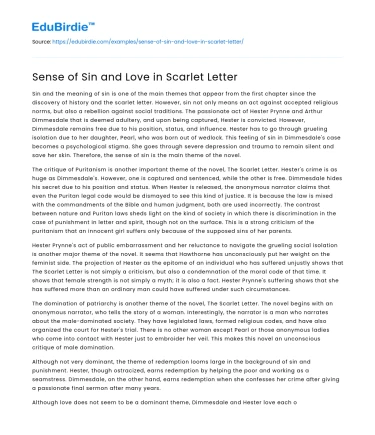Sin and the meaning of sin is one of the main themes that appear from the first chapter since the discovery of history and the scarlet letter. However, sin not only means an act against accepted religious norms, but also a rebellion against social traditions. The passionate act of Hester Prynne and Arthur Dimmesdale that is deemed adultery, and upon being captured, Hester is convicted. However, Dimmesdale remains free due to his position, status, and influence. Hester has to go through grueling isolation due to her daughter, Pearl, who was born out of wedlock. This feeling of sin in Dimmesdale's case becomes a psychological stigma. She goes through severe depression and trauma to remain silent and save her skin. Therefore, the sense of sin is the main theme of the novel.
The critique of Puritanism is another important theme of the novel, The Scarlet Letter. Hester's crime is as huge as Dimmesdale's. However, one is captured and sentenced, while the other is free. Dimmesdale hides his secret due to his position and status. When Hester is released, the anonymous narrator claims that even the Puritan legal code would be dismayed to see this kind of justice. It is because the law is mixed with the commandments of the Bible and human judgment, both are used incorrectly. The contrast between nature and Puritan laws sheds light on the kind of society in which there is discrimination in the case of punishment in letter and spirit, though not on the surface. This is a strong criticism of the puritanism that an innocent girl suffers only because of the supposed sins of her parents.
Hester Prynne's act of public embarrassment and her reluctance to navigate the grueling social isolation is another major theme of the novel. It seems that Hawthorne has unconsciously put her weight on the feminist side. The projection of Hester as the epitome of an individual who has suffered unjustly shows that The Scarlet Letter is not simply a criticism, but also a condemnation of the moral code of that time. It shows that female strength is not simply a myth; it is also a fact. Hester Prynne's suffering shows that she has suffered more than an ordinary man could have suffered under such circumstances.
The domination of patriarchy is another theme of the novel, The Scarlet Letter. The novel begins with an anonymous narrator, who tells the story of a woman. Interestingly, the narrator is a man who narrates about the male-dominated society. They have legislated laws, formed religious codes, and have also organized the court for Hester's trial. There is no other woman except Pearl or those anonymous ladies who come into contact with Hester just to embroider her veil. This makes this novel an unconscious critique of male domination.
Although not very dominant, the theme of redemption looms large in the background of sin and punishment. Hester, though ostracized, earns redemption by helping the poor and working as a seamstress. Dimmesdale, on the other hand, earns redemption when she confesses her crime after giving a passionate final sermon after many years.
Although love does not seem to be a dominant theme, Dimmesdale and Hester love each other during her husband's absence. The result is the birth of Pearl. It is out of love for Dimmesdale that Hester does not reveal her identity. She is shown as an epitome of love who never tries to expose her lover. Her silent sacrifice wins Dimmesdale in the end, and he agrees to take her to England.






 Stuck on your essay?
Stuck on your essay?

